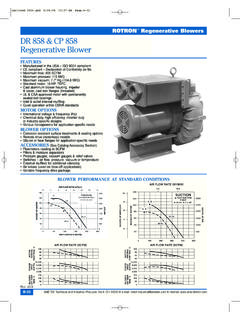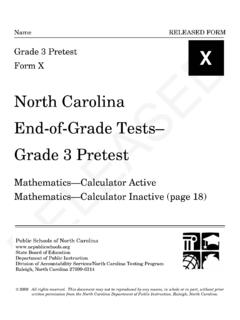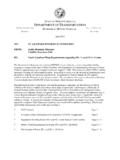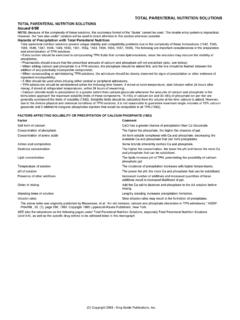Transcription of Iron Core and Ironless Motors Linear Servo Motors
1 Linear Servo MotorsIron core and IronlessLinear Servo MotorsMotorsProduct OverviewMotorsLEU-15-1 LEU-15-2 LEU-15-3 LCE-S-1 LCE-S-2 LCE-S-3 LEU-30-1 LEU-30-2 LEU-30-3 LCK-S-1 LCK-S-2 LCK-S-3 LEM-S-1 LEM-S-2 LEM-S-3 LEM-S-4LC-30-100LC-30-200LC-30-300LC-30- 400 LEA-S-2 LEA-S-4 LEA-S-6 LEA-S-8LC-50-100LC-50-200LC-50-300LC-50- 400 LEB-S-2 LEB-S-4 LEB-S-6 LEB-S-8LC-100-100LC-100-200LC-100-300LC- 100-400LC-100-600 LEC-S-1 LEC-S-2 LEC-S-3 LEC-S-4LC-150-100LC-150-200LC-150-300LC- 150-400LC-200-100LC-200-200LC-200-300LC- 200-400 ANORAD PATENTED BRUSHLESS Servo MOTORSIRON core MOTORSIRONLESS MOTORSPeak Force RangeModelForce (N)10100100010000100000LC-200LC-150LC-10 0LC-50LC-30 LCKLCELECLEBLEALEMLEU-30 LEU-15 ModelForce (N)
2 Continuous Force Range110100100010000LC-200LC-150LC-100LC -50LC-30 LCKLCELECLEBLEALEMLEU-30 LEU-15 High force per motor size, lower magnet assembly cost, excellent cooling, ideal for point to point precision, smooth motion, no cogging, no magneticattraction, ideal for scanning and of Linear MotorsUnlimited TravelAnorad Motors do not have limitations on travel the stationary magnet assemblies can be easily joinedtogether to form any length of motor , travel can be made aslong as necessary. Since the same moving coil assembly couldbe used for any travel, there is no trade-off in performance as afunction of travel.
3 Screw driven systems, on the other hand,have critical speed limitations and higher inertia with addedlength. Speed limitations, high inertia, and low stiffness aremajor performance trade-offs with larger travels with otherdrive Linear Servo Motors can be used in both very low andvery high velocity applications, all with very high can precisely operate at velocities ranging from less than1 m/sec ( /sec) to more than 10 m/sec (400 /sec). Ballscrews and lead screws have critical speed limitations. Beltdrives exhibit lower stiffness. Rack-and-pinion drives typicallyhave backlash and poor low velocity Linear Motors have a high ratio of peak force to motorinertia (about 30:1).
4 Therefore, almost all the motor force canbe used to accelerate the moving load and perform usefulwork. In typical screw-driven systems, a large portion of themotor torque is lost in overcoming the rotary inertia of themotor, coupling and Of MotionBrushless Linear Servo Motors can provide extremely smoothmotion, since they have no contacting surfaces to cause smooth motion is achieved with Anorad s sinusoidal-commutated non-ferrous Motors . By contrast, ball screws arenot as smooth due to the vibrating nature of the balls enteringand exiting the ball nut raceways, which is easily observed insub-micron systems.
5 Belt and rack-and-pinion drives also havecontacting mechanisms which are susceptible to friction andbacklash caused and RepeatabilityWith Anorad Linear Motors , the only limit to total systemaccuracy and repeatability is the sensing device and thebearings of the positioning system. In rotary driven systemsthere are additional factors which effect these performancevariables, including backlash, hysteresis, lost motion and Linear Servo Motors have very high stiffness, typicallyhigher than a stage s bearings and structural members. Withball screws and rack-and-pinion drives, the couplings, ball nut,and pinions are the highest contributors to low stiffness of astage.
6 Low stiffness reduces frequency response and increasessettling and Life ExpectancyAnorad brushless Linear Servo Motors have no contactbetween the two workingmembers. Therefore, theyhave an extremely long,virtually maintenance-free life. The non-contact designeliminates lubrication andperiodic adjustment tocompensate for wear. Rotary driven mechanismsrequire regular lubrication and occasional replacementdue to andVacuum ApplicationsSince the coil assembly andthe magnet assembly of Linear Servo Motors do not makecontact, they are ideally suited for clean room and vacuumapplications.
7 Anorad manufactures Linear Motors specificallyfor 10-7torr and vacuum applications, using special materialand manufacturing motor Section ContentsIronless Linear MotorsLEU 96 LEM98 LEA100 LEB102 LEC104 iron core Linear MotorsLC-30106LC-50108LC-100110LC-150112 LC-200114 LCK116 LCE118 Ordering Information120 Technical Notes124 Motors ?????????Common QuestionsMotorsHow Do They Work? Linear Servo Motors essentially work the same as rotary Motors , onlyopened up and laid out flat. Each motor is made of only two parts a coil assembly and a magnet assembly as shown coil assembly encapsulatescopper windings within a corematerial ( epoxy, steel).
8 The copper windings conductcurrent (I). The magnetassembly consists of rare earthmagnets, mounted in alternating polarity on a steel plate, whichgenerate magnetic flux density (B). When the current and the fluxdensity interact, force (F) is generated in the direction shown above,where F = I x Critical Is Mechanical Alignment?The coil assembly is typically attached to the moving portion ofthe machine. The magnet channel is usually fixed to the machinebase. The air gap between the two motor elements is ( ). The gap can vary as much as mm ( )without appreciable loss of There Magnetic Attraction Between The motor Parts?
9 There are two basic classifications of permanent magnet servomotors: epoxy core ( non-ferrous, slotless) and steel of these classifications include an epoxy/steel s epoxy core Motors have coils wound within epoxysupport. Therefore, these Motors produce extremely smoothmotion and have no magnetic attraction. Anorad s steel core coilassembly Motors use the steel to focus the magnetic flux, thusproducing very high force density. The steel in the coils isattracted to the permanent magnets in a direction perpendicular(normal) to the operated motor force. Magnetic attraction is aconstant force and is present whether or not the motor iselectrically energized.
10 Depending on the motor type, the normalforce of the magnetic attraction can be up to 10 times thecontinuous force rating of the Is The Cogging Level In Linear Motors ?Cogging is a form of magnetic detenting that occurs when a coil s steel laminations cross the alternating poles of the motor s rare-earth magnets. Cogging is negligible in non-ferrousmotors (LEU, LEM, LEA, LEB, LEC). Cogging in steel core Motors (LC-30/50/100/150/200, LCK) is typically +/-5% of the motor scontinuous force Is The Magnetic Flux In Linear Motors ?The magnetic flux density within the air gap of Linear Motors istypically several thousand gauss.





